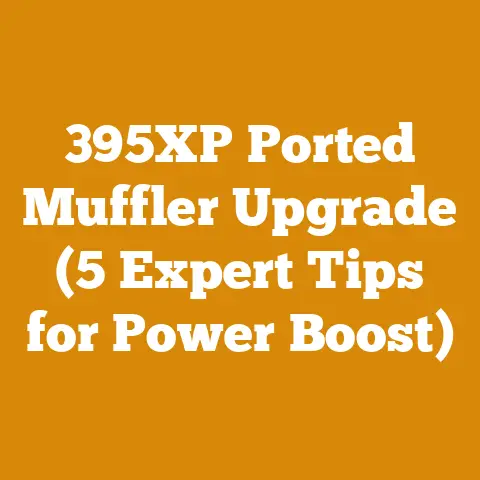Pellet Corn Efficiency (5 Insider Tips for Optimal Heat Output)
I remember shivering in my old farmhouse, the thermostat cranked, and still feeling the chill seep in through the walls. The old oil furnace groaned and guzzled fuel, sending my heating bills soaring. Fast forward to today: the same farmhouse, but a world of difference. Now, a cozy warmth radiates through every room, fueled by my pellet corn stove. And the best part? My heating costs have plummeted. The secret? Learning to maximize the efficiency of burning pellet corn.
Pellet Corn Efficiency: 5 Insider Tips for Optimal Heat Output
The global firewood and wood pellet market is a dynamic one. According to recent reports, the global wood pellet market was valued at over $9 billion in 2023 and is projected to reach over $15 billion by 2030. This growth is fueled by the increasing demand for renewable energy sources and the rising cost of fossil fuels. While wood pellets are a common choice, pellet corn offers a compelling alternative, especially in regions where corn is readily available. However, achieving optimal heat output with pellet corn requires understanding its unique characteristics and employing specific techniques. Let’s dive into the insider tips that will transform your pellet corn burning experience.
Understanding Pellet Corn as a Fuel Source
Before we get to the tips, let’s level-set. What exactly is pellet corn, and why consider it? Pellet corn is simply dried corn kernels that have been compressed into small, uniform pellets.
- Why Corn? Corn is a renewable resource, and in many agricultural areas, it’s abundant and relatively inexpensive. When burned correctly, it can provide a significant amount of heat.
- BTU Content: The BTU (British Thermal Unit) content of pellet corn typically ranges from 7,000 to 8,000 BTU per pound. This is slightly lower than wood pellets (which usually fall in the 8,000 to 9,000 BTU range), but the cost savings can often offset this difference.
- Ash Content: Pellet corn tends to produce more ash than wood pellets, which is something we’ll address in the tips below.
- Moisture Content: Aim for pellet corn with a moisture content of 12% or less for optimal burning.
Tip #1: Invest in the Right Stove – Or Adapt Your Existing One
This is the cornerstone of efficient pellet corn burning. Not all pellet stoves are created equal, and many are designed primarily for wood pellets. Using corn in a stove that isn’t equipped to handle it is like trying to drive a nail with a screwdriver – it’s just not going to work well.
-
Corn-Specific Stoves: These stoves are designed with features like larger ash pans, more robust auger systems, and adjustable air intakes to handle the unique characteristics of corn. They often have burn pots designed specifically for corn.
-
Multi-Fuel Stoves: Some stoves are designed to burn a variety of fuels, including wood pellets, corn, and even cherry pits. These are a good option if you want flexibility.
-
Adapting Your Wood Pellet Stove: If you already have a wood pellet stove, don’t despair! You might be able to adapt it. However, this requires careful consideration and potentially some modifications.
- Burn Pot Inserts: Look for aftermarket burn pot inserts designed for burning corn in wood pellet stoves. These inserts help to improve airflow and combustion.
- Adjusting Air Intake: Pellet corn requires more air for complete combustion than wood pellets. You might need to adjust the air intake settings on your stove. Caution: Consult your stove’s manual or a qualified technician before making any adjustments. Improper adjustments can lead to incomplete combustion, increased smoke, and even stove damage.
- Auger System: The auger (the mechanism that feeds fuel into the burn pot) might need to be adjusted or even replaced to handle the larger size and different flow characteristics of pellet corn. Some wood pellet stoves may struggle to feed corn properly, leading to inconsistent burning.
-
Data Point: According to a study by Iowa State University, using a corn-specific stove can improve heating efficiency by as much as 20% compared to using an unmodified wood pellet stove.
Too little air, and you’ll get incomplete combustion, leading to smoke, soot, and wasted fuel. Too much air, and you’ll cool down the burn pot, reducing the overall heat output.-
Understanding the Airflow Controls: Your stove likely has multiple airflow controls. One controls the primary air intake (the air that feeds the burn pot), and another controls the secondary air (air that helps to burn off any remaining gases). Consult your stove’s manual to understand how these controls work.
-
The “Smoke Test”: This is a simple but effective way to gauge your airflow. Light your stove and observe the smoke coming from the chimney.
- Black Smoke: Indicates incomplete combustion and too little air. Increase the primary air intake.
- White Smoke: Can indicate either too much moisture in the corn or too much air. Check the moisture content of your corn and, if necessary, reduce the primary air intake slightly.
- Clear or Light Gray Smoke: This is what you’re aiming for. It indicates efficient combustion.
-
The Flame Test: Observe the flame in the burn pot.
- Lazy, Orange Flames: Suggest incomplete combustion. Increase the primary air intake.
- Small, Blue Flames: Indicate too much air. Reduce the primary air intake.
- Bright, Yellow Flames with a Slight Blue Base: This is the ideal flame pattern, indicating efficient combustion.
-
Iterative Adjustments: Airflow adjustments are rarely a one-time thing. You’ll need to monitor your stove and make adjustments as needed, depending on the weather, the quality of your corn, and even the time of day. Think of it like tuning a musical instrument – it takes practice and a keen ear (or, in this case, a keen eye and nose).
-
Personal Story: I once spent an entire afternoon tweaking the airflow on my stove, chasing that perfect flame. It was frustrating at times, but the payoff was significant: a noticeable increase in heat output and a reduction in the amount of ash produced.
Tip #3: Embrace Regular Cleaning and Maintenance
Pellet corn produces more ash than wood pellets, and this ash can quickly accumulate in the burn pot, ash pan, and exhaust system. Neglecting regular cleaning will significantly reduce your stove’s efficiency and can even lead to malfunctions.
-
Daily Burn Pot Cleaning: This is non-negotiable. Use a scraper or poker to remove any clinkers (hard, fused masses of ash) and unburned corn from the burn pot. A clean burn pot ensures proper airflow and efficient combustion.
-
Ash Pan Emptying: Empty the ash pan at least every few days, or more frequently if you’re burning a lot of corn. A full ash pan can restrict airflow and reduce heating efficiency.
-
Weekly Vent Cleaning: Use a brush and vacuum to clean the exhaust vent. This is crucial for maintaining proper airflow and preventing dangerous carbon monoxide buildup. Safety First: Always disconnect the stove from the power source before cleaning the vent.
-
Annual Deep Cleaning: Once a year, give your stove a thorough cleaning. This includes:
- Inspecting and cleaning the blower: The blower is responsible for circulating air through the stove. A dirty blower will reduce airflow and heating efficiency.
- Inspecting and cleaning the auger: Make sure the auger is free of debris and moving smoothly.
- Inspecting and cleaning the heat exchanger: The heat exchanger transfers heat from the combustion chamber to the air that circulates through your home. A dirty heat exchanger will reduce heating efficiency.
- Professional Inspection: Consider having a qualified technician inspect your stove annually to identify any potential problems and ensure that it’s operating safely and efficiently.
-
Case Study: A local school district switched to pellet corn heating in their gymnasium. Initially, they experienced lower-than-expected heat output. Upon investigation, it was discovered that the maintenance staff was not cleaning the stoves frequently enough. Once a regular cleaning schedule was implemented, the heating efficiency improved dramatically, and the school district realized significant cost savings.
Tip #4: Source High-Quality Pellet Corn and Store it Properly
The quality of your pellet corn has a direct impact on its heating efficiency. Just like with firewood, not all corn is created equal.
-
Look for Certified Pellet Corn: Some manufacturers offer certified pellet corn that meets specific quality standards. This certification ensures that the corn is dry, clean, and free of contaminants.
-
Check the Moisture Content: As mentioned earlier, aim for pellet corn with a moisture content of 12% or less. Higher moisture content will reduce heating efficiency and increase the risk of clinkers forming in the burn pot. Use a moisture meter to test the moisture content of your corn.
-
Inspect for Foreign Materials: Look for any foreign materials, such as dirt, stones, or weed seeds. These contaminants can clog the auger, reduce heating efficiency, and even damage your stove.
-
Proper Storage is Key: Store your pellet corn in a dry, well-ventilated area. Moisture is the enemy.
- Elevated Storage: Store the corn on pallets or other elevated surfaces to prevent moisture from wicking up from the floor.
- Airtight Containers: Consider storing the corn in airtight containers to protect it from moisture and pests.
- Avoid Direct Sunlight: Direct sunlight can degrade the corn and reduce its heating value.
-
Cost Considerations: While high-quality pellet corn may cost slightly more upfront, the increased heating efficiency and reduced maintenance costs will often offset the difference in the long run. Think of it as an investment in your heating system.
Tip #5: Fine-Tune Your Stove Settings for Optimal Performance
Even with the right stove, proper airflow, regular cleaning, and high-quality fuel, you still need to fine-tune your stove settings to achieve optimal performance. This is where experimentation and observation come into play.
-
Start with the Manufacturer’s Recommendations: Your stove’s manual should provide recommended settings for burning pellet corn. Start with these settings as a baseline.
-
Adjust the Feed Rate: The feed rate controls the amount of corn that is fed into the burn pot. If you’re seeing a lot of unburned corn in the ash pan, reduce the feed rate. If the flame is weak or the stove is struggling to maintain temperature, increase the feed rate.
-
Adjust the Airflow (Again!): As you adjust the feed rate, you’ll likely need to make further adjustments to the airflow. Use the “smoke test” and “flame test” described earlier to fine-tune the airflow.
-
Monitor the Ash Production: Keep an eye on the amount of ash produced. Excessive ash production can indicate incomplete combustion or low-quality fuel.
-
Track Your Fuel Consumption: Keep track of how much corn you’re burning and how much heat you’re getting. This will help you to identify the most efficient settings for your stove and your home.
-
Embrace the Learning Curve: Fine-tuning your stove settings is an ongoing process. Don’t be afraid to experiment and try different settings until you find what works best for you.
-
Unique Insight: I discovered that slightly pre-heating my burn pot before adding a full load of pellets significantly improved the initial burn and reduced smoke during startup. It’s a small thing, but it made a noticeable difference.
Troubleshooting Common Pellet Corn Burning Problems
Even with the best preparation, you might encounter some common problems when burning pellet corn. Here’s a quick troubleshooting guide:
-
Problem: Excessive Smoke
- Possible Causes: Incomplete combustion, too little air, wet corn, dirty stove.
- Solutions: Increase the primary air intake, check the moisture content of the corn, clean the burn pot and exhaust vent.
-
Problem: Clinkers in the Burn Pot
- Possible Causes: High ash content in the corn, too much moisture, improper airflow.
- Solutions: Use higher-quality corn, ensure proper airflow, clean the burn pot regularly.
-
Problem: Stove Won’t Stay Lit
- Possible Causes: Low feed rate, insufficient airflow, clogged auger.
- Solutions: Increase the feed rate, check the airflow, clean the auger.
-
Problem: Low Heat Output
- Possible Causes: Inefficient combustion, dirty stove, poor-quality fuel.
- Solutions: Fine-tune the airflow, clean the stove, use higher-quality corn.
-
Problem: Auger Clogging
- Possible Causes: Foreign materials in the corn, oversized corn pellets.
- Solutions: Inspect the corn for foreign materials, use properly sized corn pellets.
The Economics of Pellet Corn Heating
Let’s talk about the bottom line. Is pellet corn heating actually cheaper than other heating options? The answer, as always, is it depends.
-
Corn Prices: The price of corn fluctuates depending on the region and the time of year. Check with local farmers or grain elevators for current prices.
-
Stove Costs: The initial cost of a pellet corn stove can be higher than that of a wood pellet stove. However, the increased efficiency and potential fuel savings can offset this difference over time.
-
Maintenance Costs: Pellet corn stoves require more frequent cleaning than wood pellet stoves, which can increase maintenance costs.
-
Comparison with Other Fuels: Compare the cost of pellet corn heating with the cost of other fuels, such as natural gas, propane, and oil. Consider not only the fuel costs but also the cost of equipment and maintenance.
-
Regional Variations: The economics of pellet corn heating vary significantly depending on the region. In areas where corn is abundant and inexpensive, it can be a very cost-effective heating option. In areas where corn is scarce or expensive, it may not be as attractive.
-
Data Point: A study by the University of Minnesota found that pellet corn heating can be up to 40% cheaper than propane heating in some areas.
Next Steps and Additional Resources
Ready to take the plunge into pellet corn heating? Here are some next steps and additional resources to help you get started:
- Research Pellet Corn Stoves: Explore different brands and models of pellet corn stoves to find one that suits your needs and budget. Read reviews and compare features.
- Contact Local Suppliers: Contact local farmers or grain elevators to inquire about the availability and price of pellet corn.
- Consult with a Heating Professional: Talk to a qualified heating professional to get advice on the best heating solution for your home.
- Join Online Forums: Join online forums and communities dedicated to pellet corn heating. These forums are a great place to ask questions, share tips, and learn from other users.
- Check for Government Incentives: Some governments offer incentives for installing renewable energy heating systems, such as pellet corn stoves. Check with your local government for available programs.
Suppliers of Logging Tools and Drying Equipment (Relevant for Corn Production):
While this guide focuses on burning pellet corn, ensuring a sustainable supply often involves efficient harvesting and drying practices. Here are some resources that can be helpful for corn producers:
- Logging Tool Suppliers: For harvesting corn stalks and other biomass, consider suppliers like Baileys (baileysonline.com) or Northern Tool + Equipment (northerntool.com). They offer chainsaws, axes, and other tools that can be used for biomass harvesting.
- Drying Equipment Rental Services: Companies like AggrowTech (aggrowtech.com) specialize in drying equipment for agricultural products, including corn. Renting equipment can be a cost-effective option for smaller-scale producers.
- Agricultural Equipment Dealers: Local agricultural equipment dealers can provide information on harvesting and drying equipment specific to corn production.
By following these tips and resources, you can unlock the full potential of pellet corn heating and enjoy a warm, comfortable home while saving money and reducing your carbon footprint. It’s a win-win situation!
Conclusion: Embracing the Potential of Pellet Corn
Pellet corn heating presents a compelling alternative to traditional heating fuels, particularly for those in agricultural regions where corn is readily available. While it requires a bit more attention and effort than burning wood pellets, the potential cost savings and environmental benefits make it a worthwhile endeavor. By investing in the right stove, mastering the art of airflow adjustment, embracing regular cleaning, sourcing high-quality fuel, and fine-tuning your stove settings, you can unlock the full potential of pellet corn heating and enjoy a warm, comfortable home while reducing your reliance on fossil fuels. So, go ahead, give it a try. You might just be surprised at how much you like it.
-






